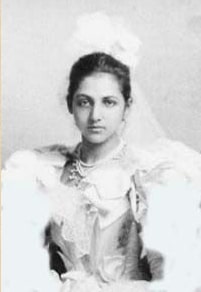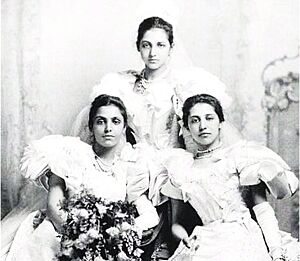Catherine Hilda Duleep Singh facts for kids
Quick facts for kids Catherine Hilda Duleep Singh |
|||||
|---|---|---|---|---|---|

Singh at her debut, Buckingham Palace, 1894
|
|||||
| Born | Catherine Hilda Duleep Singh 27 October 1871 Elveden Hall, Elveden, Suffolk, England |
||||
| Died | 8 November 1942 (aged 71) Penn, Buckinghamshire |
||||
|
|||||
| Religion | Sikhism | ||||
Princess Catherine Hilda Duleep Singh (born 27 October 1871 – died 8 November 1942) was a fascinating princess with a big heart. She was the second daughter of Maharaja Sir Duleep Singh and Maharani Bamba.
Catherine grew up and was educated in England. In 1894, she was officially introduced to society at Buckingham Palace. Like her sisters, she believed in women's rights. She became a suffragist, meaning she supported the idea of women being able to vote. However, she did not join the more active "Suffragette" movement, unlike her sister Sophia.
For most of her adult life, Catherine lived with her close friend and former governess, Lina Schäfer, in Germany. They lived together from 1904 until Lina's death in 1937. During World War II, Catherine and Lina bravely helped many Jewish families escape from Germany.
In 1997, a bank account belonging to Catherine and Lina was found in a Swiss bank. After some discussion, the money was given to the family of a secretary who had worked for Catherine's elder sister, Bamba.
Early Life and Education
Catherine Hilda Duleep Singh was born on 27 October 1871. Her birthplace was Elveden Hall in Suffolk, England. She was the second daughter of Maharaja Duleep Singh and Bamba Müller.
Catherine had two older siblings: a brother named Victor Albert Jay and a sister named Bamba Sofia Jindan. She also had a younger sister, Sophia Alexandra. Sophia later became very famous for her work as a suffragette. Catherine also had two younger brothers, Frederick Victor and Albert Edward Alexander. Later, her father remarried and had two more daughters, Pauline and Ada.
In 1886, Catherine's father tried to move his family to India. However, he was stopped and had to return from Aden. Catherine and her sisters then stayed in Folkestone, England. During this time, Catherine met Fräulein Lina Schäfer. Lina was a German teacher and governess. She was twelve years older than Catherine. The two became very close friends, and their bond lasted for the rest of Lina's life.
Catherine and her older sister Bamba studied at Somerville College in Oxford. Catherine also took private lessons in violin and singing. She was also taught how to swim. People thought Catherine was the prettiest of the three sisters. In 1895, she and her sisters were officially presented to society at Buckingham Palace. They wore beautiful white silk dresses.
Like her sister Sophia, Catherine Hilda Duleep Singh became a suffragist. She was a member of groups like the Fawcett Women's Suffrage Group. She also joined the National Union of Women's Suffrage Societies (NUWSS). These groups worked peacefully for women's right to vote.
Life in Europe
In 1903, Catherine traveled to India. She visited her family's ancestral home in Lahore. She also explored other places like Kashmir, Dalhousie, Simla, and Amritsar. She met with royal families and local people in different states.
After returning from India in March 1904, Catherine lived in Europe. She lived with her close friend Lina Schäfer. They lived in the Black Forest region, in Kassel, and in Dresden, Germany. She also visited her family in Switzerland.
Catherine spent most of her adult life living with Lina Schäfer. During World War I, she continued to live with Lina in Germany. This was a brave choice, as it could have made her seem disloyal to Britain. Catherine and Lina are known for helping many Jewish families. They helped these families escape to the United Kingdom during World War II. They even gave some families a place to stay. It seems that no one in Catherine's family had a problem with her close friendship with Lina.
Lina Schäfer passed away on 26 August 1938, at the age of 79. Catherine was very sad after Lina's death. After the Nazis came to power in Germany, Catherine was advised to leave. She sold all her property and moved to England in November 1937, traveling through Switzerland.
Passing Away
Princess Catherine Hilda Duleep Singh died from a heart attack on 8 November 1942. She passed away in Penn, England. On the evening she died, she and her sister Sophia had gone to see a play. They had dinner and then went to bed. The next morning, the maid found Catherine's room locked. Sophia broke open the door and found her sister had passed away. The doctor said she died of heart failure.
Sophia was heartbroken by her sister's death. Because of World War II, Sophia was the only family member who could attend Catherine's cremation. To remember her sister, Sophia renamed her house "Hilden Hall." She added Catherine's middle name to the house name. She also sealed the room where Catherine had died.
Catherine left a will from 1935. In it, she asked to be cremated and her ashes buried at Elveden in Suffolk. She also left her jewelry and clothes to her sisters, Bamba and Sophia. In a later addition to her will, she asked for a quarter of her ashes to be buried near Lina Schäfer's coffin in Germany. However, her will did not mention a bank account or a vault in a Swiss bank. This secret was only discovered many years later.
Swiss Bank Account
In July 1997, news broke about a list of over 5,000 old bank accounts in Swiss banks. This list was published by the Swiss Bankers Association. It was done because Holocaust survivors insisted on it. Catherine's name was on this list. Her address was listed as "Duleep Singh, Catherine (Princess), last heard of in 1942 living in Penn, Bucks." These accounts had not been used since the end of World War II.
Many people tried to claim the money from Catherine's joint account with Lina Schäfer. These included the Government of India and relatives from India and Pakistan. However, none of Duleep Singh's children had any children of their own. This meant there were no direct descendants alive. A special group was set up in Zurich to decide who should get the money.
The group heard claims for three years. The Government of India's claim was not accepted. This was because Catherine was a private citizen and not a ruler of a state. Her bank account was personal. The group also rejected claims from her relatives in India and Europe.
Finally, the group decided that the Supra family should receive the money. The Supra family were caretakers and tutors for Catherine's sister Bamba. Bamba had no children, so she had left her money to the Supra family in her will. Catherine's will had also named Bamba as a beneficiary. So, the group decided that Supra's five living sons (four in Pakistan and one in India) and his deceased daughter's children would share the money equally. The total amount was 137,323 Swiss Francs.


